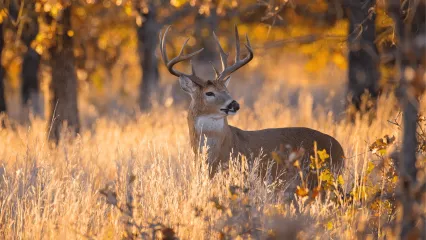
Whitegrass Flats WMA covers 391 acres and is located in McCurtain County, Oklahoma. The WMA is 7 miles south of highway 70 at the intersection of 70 and highway 98. Habitat consists of a 90 acre moist soil unit divided into three compartments. The area is mostly old farm fields with some areas replanted to hardwoods. The variety of trees include six species of oak as well as ash, hickory, pine, river birch, willow, as well as sand plum, holly, sumac, and a great variety of grasses and legumes. Soil types vary from deep sand to sandy loam. The average annual precipitation for the area is 53 inches.
From Valliant: 4 miles east on U.S. Hwy 70, 5 miles south on State Hwy 98.
- Quail: Bobwhite quail are present in very low numbers.
- Bear: Present on the area.
- Turkey: Eastern turkeys are present in very low numbers.
- Deer: Whitetail deer are present in low numbers but are highly sought after.
- Rabbit: Both cottontails and swamp rabbits may be found with cottontails being more common.
- Furbearers: Coyote, bobcat, beaver, mink, and raccoon are available.
- Dove: Dove are present in low numbers during the annual migrations.
- Waterfowl: Ducks may be present in low numbers on the open water.
- River Otter: Present on the area.
- Bald Eagle: Eagles winter at Pine Creek Lake and travel the Little River Basin.
- American Alligator: Seldom seen but are known to be in the area. No hunting allowed.
Management practices such as burning, plowing, and bush hogging are used to provide quality native plant food resources and to maintain habitat diversity. Whitegrass Flats WMA has plenty of water sources for all game and non-game species.
Camping is not available. With RV camping available at nearby Raymond Gary State Park (580) 873-2307 and Corps of engineers camp grounds at Hugo and Pine Creek lakes. Food and lodging is also available in Idabel and Valliant, Oklahoma. No rifle range facilities exist at this project.
There is no fishing at Whitegrass Flats, however area lakes (Hugo, Pine Creek and Lake Raymond Gary) offer opportunities for bass, crappie, sunfish and catfish. In addition, two nearby scenic streams (Glover River and Little River) offer excellent light tackle opportunities for smallmouth bass and sunfish.
All shotgun hunting is restricted to federally approved nontoxic shot.
Closed Seasons
Same As Statewide Seasons
Seasons w/ Special Restrictions
- Quail, Crow, Snipe, Woodcock, Rabbit, Squirrel, Pursuit with Hounds for Furbearers
Closed during the first nine days of deer gun season.
- Waterfowl
Hunting hours for waterfowl close at 1 p.m. daily on the WDU portion.
- Turkey Spring, Youth Turkey Spring
One-tom limit; seasons combined.
Closed to all air-driven watercraft.
No camping allowed.
Kiamichi Country Tourism
1-800-722-8180
Broken Bow Chamber of Commerce
1134 W Martin Luther King Jr, Broken Bow 74728
(580) 584-3393 or (800) 528-7337
chamber@pine-net.com
Hugo Area Chamber of Commerce
200 South Broadway, Hugo OK 74743
(580) 326-7511
hugochamber@lstarnet.com
www.hugochamber.com
Idabel Chamber of Commerce
13 North Central, Idabel 74745
(580) 286-3305
Oklahoma Tourism and Recreation Department
Post Office Box 52002
Oklahoma City, OK 73152-2002
(800) 652-6552 or (405) 521-2409
www.travelok.com
Controlled Hunts: Yet More Ways to Up Your Odds
Additional features continue to be added to the Wildlife Department’s controlled hunts program.
Cackling Geese Tracked in Central Flyway Study
Researchers are tracking cackling geese wintering in a five-state study area to learn more about their movements and habitat preferences.
Study Focused on Bats and Disease-causing Fungus
Bat surveys were conducted to learn more about Oklahoma’s bat communities and hundreds of bats were swabbed for the fungus that causes white-nose syndrome.


